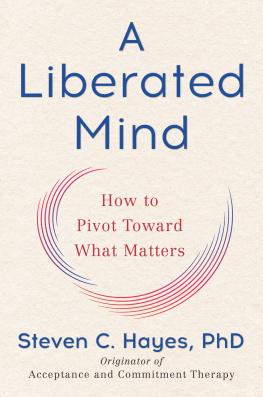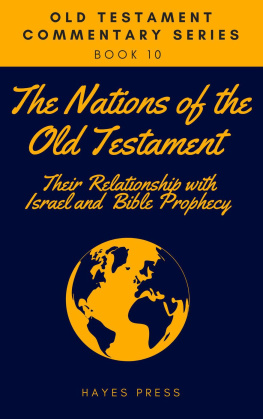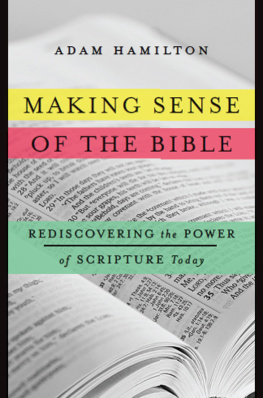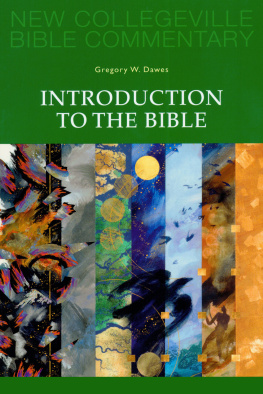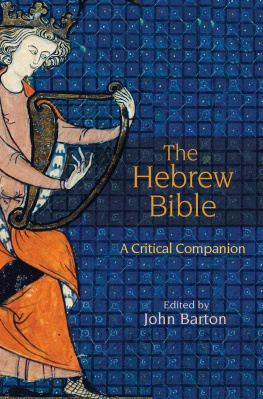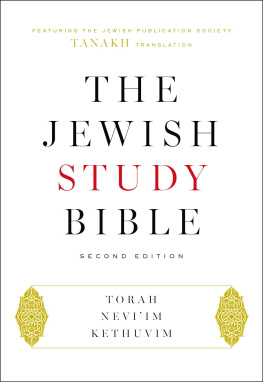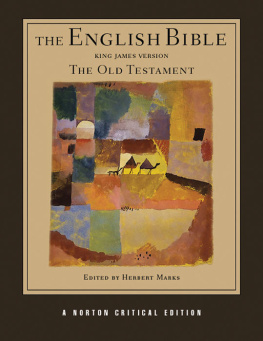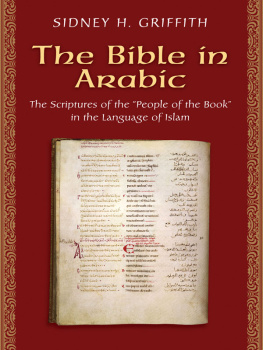Introduction to the Bible
THE OPEN YALE COURSES SERIES is designed to bring the depth and breadth of a Yale education to a wide variety of readers. Based on Yales Open Yale Courses program (http://oyc.yale.edu), these books bring outstanding lectures by Yale faculty to the curious reader, whether student or adult. Covering a wide variety of topics across disciplines in the social sciences, physical sciences, and humanities, Open Yale Courses books offer accessible introductions at affordable prices.
The production of Open Yale Courses for the Internet was made possible by a grant from the William and Flora Hewlett Foundation.
RECENT TITLES
Paul H. Fry, Theory of Literature
Christine Hayes, Introduction to the Bible
Shelly Kagan, Death
Dale B. Martin, New Testament History and Literature
Douglas W. Rae, Capitalism: Success, Crisis, and Reform
Ian Shapiro, The Moral Foundations of Politics
Steven B. Smith, Political Philosophy
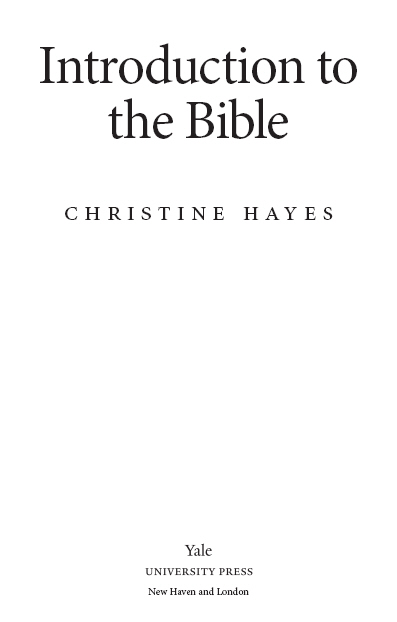
Copyright 2012 by Yale University.
All rights reserved.
This book may not be reproduced, in whole or in part, including illustrations, in any form (beyond that copying permitted by Sections 107 and 108 of the U.S. Copyright Law and except by reviewers for the public press), without written permission from the publishers.
Yale University Press books may be purchased in quantity for educational, business, or promotional use. For information, please e-mail sales.press@yale.edu (U.S. office) or sales@yaleup.co.uk (U.K. office).
Set in Minion type by Westchester Book Group
Printed in the United States of America
Biblical verses reprinted from Tanakh: The Holy Scriptures by permission of the University of Nebraska Press. Copyright 1985 The Jewish Publication Society, Philadelphia.
Table 3: From Exploring Exodus: The Heritage of Biblical Israel, by Nahum M. Sarna, copyright 1986 by Nahum M. Sarna, table appears on p. 76. Used by permission of Schocken Books, a division of Random House, Inc. For information about this and other Random House, Inc., books and authors, see the Web site at http://www.randomhouse.com.
Map 6: From The Old Testament: A Historical and Literary Introduction to the Hebrew Scriptures , by Michael Coogan, copyright 2006 by Oxford University Press, Inc., map appears on p. 403. Used by permission of Oxford University Press, Inc.
Library of Congress Cataloging-in-Publication Data
Hayes, Christine Elizabeth.
Introduction to the Bible / Christine Hayes.
pages cm (The open Yale courses series)
Includes bibliographical references and index.
ISBN 978-0-300-18179-1 (pbk.)
1. Bible. O.T.Introductions. I. Title.
BS1140.3.H39 2012
221.6'1dc23
2012022003
A catalogue record for this book is available from the British Library.
This paper meets the requirements of ANSI/NISO Z39.48-1992 (Permanence of Paper).
10 9 8 7 6 5 4 3 2 1
For my students,
real and virtual,
past, present, and future
Contents
The Biblical Creation Stories
The Stories of the Patriarchs (Genesis 1236)
Moses and the Beginning of Yahwism
Cult and Sacrifice, Purity and Holiness
Deuteronomy and the Figure of Moses
Joshua
Of Judges, Prophets, and Kings
Amos as Paradigm
Hosea and First Isaiah
Micah, Zephaniah, Nahum, Habakkuk, Jeremiah
Ezekiel and 23 Isaiah
Lamentations and Wisdom
Ecclesiastes, Psalms, and the Song of Songs
Ezra-Nehemiah and Ruth
Esther and Jonah
This book examines the small library of twenty-four books common to all Jewish and Christian Bibles everywherebooks that preserve the diverse efforts of various writers over a period of nearly a millennium to make sense of both the historical odyssey and the human experience of the ancient Israelite people. Like any library, this ancient collection contains books by many authors writing in many contexts and responding to many crises and questionspolitical, historical, socioeconomic, cultural, philosophical, religious, and moraloffering an unresolved polyphony that rewards careful reading and reflection.
The great variety and complexity of the many books of the Bible can be daunting to those who wish to understand not only its contents but also its continuing influence through history. This volume guides readers through the complex and polyphonous literature of the twenty-four biblical books that would serve as a foundational pillar of western civilization. Introducing readers to the modern methods of study that have led to deep and powerful insights into the original context and meaning of biblical texts, this book traces the diverse strands of Israelite culture and thought incorporated in the Bible, against the backdrop of their historical and cultural setting in the ancient Near East. It probes the passionate and highly fraught struggle of different biblical writers to understand and represent their nations historical experience and covenantal relationship with its god.
The twenty-four chapters that constitute the present volume are based on the twenty-four lectures presented in my undergraduate course Introduction to the Old Testament, which is widely available online through Yale Universitys Open Yale Courses project (http://oyc.yale.edu/). This volume is not an exact transcript of those lectures; it revises and adapts them for a written format. At times a different order of presentation is adopted. Repetitions and infelicitous formulations have been deleted, and some new material has been incorporatedin particular, close analysis of primary sources and biblical texts that, in the context of the Yale course, was undertaken by students in small discussion sections.
By their very nature as introductory, the course and the current volume do not represent my own original research. Rather, they draw upon and synthesize a vast body of existing scholarship on the Bible of ancient Israelespecially the writings of Michael Coogan, Moshe Greenberg, Yehezkel Kaufmann, Jonathan Klawans, Jacob Milgrom, Nahum Sarna, and the excellent scholarly essays in The Jewish Study Bible, edited by Adele Berlin and Marc Brettler (New York: Oxford University Press, 2004). Readers will also see some correspondences between the present volume and two summary chapters on biblical Israel in my textbook The Emergence of Judaism: Classical Traditions in Contemporary Perspectives (Minneapolis, MN: Fortress Press, 2010).
Chapter 1 is a general introduction to the Bible in its ancient Near Eastern context. Chapters 2 through 15 follow the narrative chronology of the Bible, from Genesis through 2 Kings. Readers should be aware that the narrative sequence does not reflect the compositional sequence of the Bible. In other words, and as just one example, most scholars now agree that parts of Genesis were written long after parts of Exodus or Deuteronomy or Isaiah. Many biblical books came into being through the accretion of various materials over the course of centuries. Thus, while following the narrative chronology imposed by the final redactor of Genesis through 2 Kings, we will simultaneously attend to the compositional history of the text, noting the likely provenance of the various units that make up the final redacted biblical text and considering how and why the text acquired the form we see today. Chapters 16 through 19 examine the books of the prophets in historical sequence rather than canonical sequence, and chapters 20 through 24 take a somewhat thematic approach to the books collected in the section of the Hebrew Bible known as the Writings.
Readers of this volume will derive maximum benefit if they are familiar with the biblical material analyzed in each chapter. Thus, readers are strongly urged to read the relevant biblical passages listed at the beginning of each chapter. However, even readers unable to complete the biblical readings will learn much from the presentations and discussions in this book.
Next page

